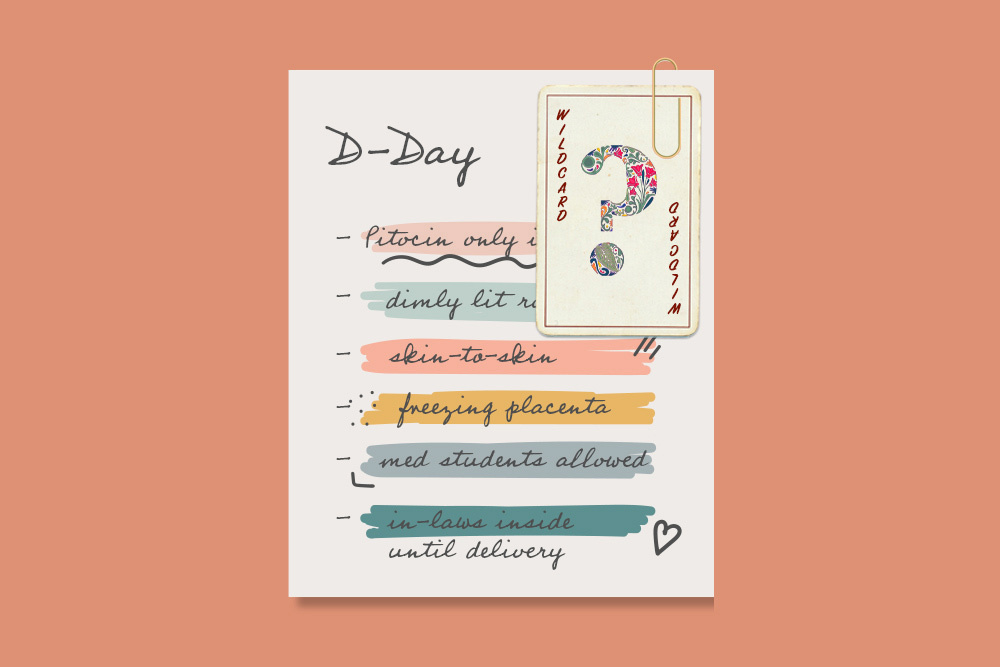The Birth Plan Checklist for Expectant Moms

Here’s everything to consider when making an agenda for your big day.
From the first positive pregnancy test, many moms-to-be fret over labor and all its unknowns. Writing a birth plan can help relieve your anxiety, and—like Kegels! —it’s a valuable pre-delivery exercise.
A birth plan is not actually a plan, per se, but a short document sharing your delivery desires with anyone helping to welcome your baby. Much of your birth experience will be dictated by the setting you select (whether that be a hospital, birthing center or home setting) and the caregivers assisting, so it’s important to learn your options before penning your birth preferences. And make sure you’re not writing your birth plan in stone, since it’s impossible to completely control how your bundle of joy will make his grand entrance.
Here are worthy topics to ponder when drafting your birth plan:
Birth Setting Policies
Rules apply in childbirth. To give you an idea, you may want the freedom to eat and drink during labor, but many hospitals limit your consumption to ice chips. Get familiar with your delivery location’s policies ahead of time to know what’s possible and what’s not.
Procedures of Your Healthcare Provider
If you want to have a water birth, for example, make sure your doc is willing to reach into the tub.
Delivery Room Attendees
Medical students may observe in hospitals, but you can ban them from your room if you feel like a floor show. Also, decide if your MIL gets to hold your hand or if your husband and doula are a sufficient birth team.
Wardrobe
Hospitals might assume you’ll don the standard gown, but this may not be the chic outfit you want captured in your baby’s first photos. (Remember that whatever you wear, it’s going to get messy, so choose your own clothes wisely!)
Atmosphere
Do you want a high-energy ambiance with jazzy music or a quiet, softly lit setting for your baby’s birth?
Interventions
What are your feelings on inducing labor? Do you have a preference between a medical induction method, like Pitocin, or something considered natural, such as a foley bulb?
Pain Management
Is your strategy “Get an epidural ASAP!” or do you want to avoid pain medications if possible? What pain relief techniques will you use?
Monitoring
Many hospitals use constant electronic fetal monitoring, but if you don’t want to be bedridden, intermittent monitoring may be an option.
IV
Most laboring women are tethered to IVs, but your healthcare provider may allow you the option of consuming liquids orally instead of intravenously.
Laboring Options and Equipment
Do you want to use a birthing ball, birthing stool or bar during contractions to help with labor pain? Does your facility provide these items, or can you bring your own if needed?
Episiotomies and Assisted Birth
If your baby is being bashful, your caregiver may wish to perform an episiotomy—an incision between the vagina and anus—or use forceps or vacuum extraction. Discuss the pros and cons of each in advance.
C-section
In what circumstances would you want a cesarean section to be performed? Does five hours of pushing grant a ticket to the OR or is your baby’s distress the only call for surgery?
Photos and Videos
Do you wish to document every moment from the first twinge through baby’s first bath, or hold the flashbulbs until all are clean and content?
Crowning
Some non-squeamish mothers request to have a mirror positioned so they can see the baby crown (when his head first appears) or even reach down and touch his tiny noggin. Decide and cement it, so you won’t miss the big moment.
Cutting the Cord
Indicate when you’d like baby’s umbilical cord to be clamped, and specify whether your partner or support person wants to take part in the snipping ritual.
Placenta
Communicate if planning to freeze or send your placenta off for encapsulation. If not, it will promptly be thrown into a biohazard bin.
Postbirth
After a vaginal delivery, you may want baby immediately placed on your chest. (This is consistent with golden-hour practices across most hospital policies and procedures.) For a C-section, indicate who should bond with your baby while you recover.
Nursing
You may wish to start breastfeeding right away; you can also kindly instruct the hospital staff not to offer baby a bottle or pacifier, which could interfere with nursing.
Newborn Care
Do you want your newbie’s first bath to be at the hospital, or would you rather wait until a later time? (Some parents opt to delay initial bathing in an effort to promote skin-to-skin and breastfeeding, to maintain the sacred new-baby smell, and to preserve baby’s vernix, the white, waxy, moisturizing substance found on the skin at birth.) Also discuss all routine procedures (including vaccinations, the vitamin K shot and administering erythromycin eye ointment) with your provider beforehand and specify if you’ll be forgoing any of these options.
Additional Info
Mention factors that may affect your delivery, like if you’re blind as a bat without glasses, have gestational diabetes, or wish to bank baby’s cord blood.
Don’t forget: While creating a birth plan is a great idea, don’t get so attached to it that you won’t allow any flexibility in the delivery room. Birth is different for every woman, every time, so no matter how much you plan there’s a good chance things won’t go exactly the way you envisioned them. Remember to expect the unexpected!
Emily Lovely







